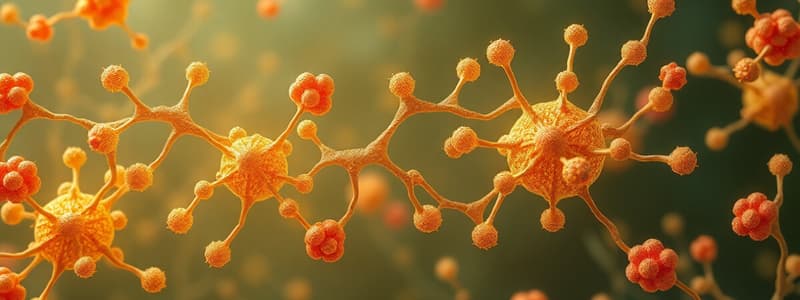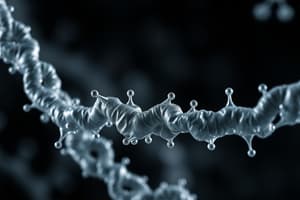Podcast
Questions and Answers
What role do carbohydrates primarily serve in living organisms?
What role do carbohydrates primarily serve in living organisms?
- Facilitate cellular respiration
- Transport molecules across the cell membrane
- Provide energy and structural support (correct)
- Store genetic information
Which biomolecule is primarily responsible for catalyzing reactions within the cell?
Which biomolecule is primarily responsible for catalyzing reactions within the cell?
- Nucleic acids
- Carbohydrates
- Lipids
- Proteins (correct)
What is the main structural component of the cell membrane?
What is the main structural component of the cell membrane?
- Fatty acid chains exclusively
- Phospholipid bilayer (correct)
- Carbohydrates
- Proteins only
What distinguishes prokaryotic cells from eukaryotic cells?
What distinguishes prokaryotic cells from eukaryotic cells?
Which process involves the movement of substances across the cell membrane without the use of energy?
Which process involves the movement of substances across the cell membrane without the use of energy?
What is the primary function of nucleic acids in cells?
What is the primary function of nucleic acids in cells?
Which organelle is primarily involved in energy production?
Which organelle is primarily involved in energy production?
Which mechanism of cell transport requires energy from ATP?
Which mechanism of cell transport requires energy from ATP?
What is the primary function of epithelial tissue?
What is the primary function of epithelial tissue?
Which type of tissue is characterized by a large amount of extracellular matrix?
Which type of tissue is characterized by a large amount of extracellular matrix?
What type of muscle tissue is under involuntary control?
What type of muscle tissue is under involuntary control?
Which level of organization directly follows tissues in the biological hierarchy?
Which level of organization directly follows tissues in the biological hierarchy?
What is a characteristic feature of nervous tissue?
What is a characteristic feature of nervous tissue?
Flashcards
Biomolecules
Biomolecules
Large molecules essential for life, primarily composed of carbon, hydrogen, oxygen, nitrogen, and phosphorus.
What is epithelial tissue?
What is epithelial tissue?
Epithelial tissue covers surfaces, lines cavities, and forms glands. It's characterized by tightly packed cells with little extracellular matrix. It performs functions like protection, secretion, absorption, and excretion.
Carbohydrates
Carbohydrates
Carbohydrates are a group of biomolecules that provide energy and structural support. They are made up of simple sugars like glucose that combine to form complex carbohydrates like starch and cellulose.
What is connective tissue?
What is connective tissue?
Signup and view all the flashcards
What is muscle tissue?
What is muscle tissue?
Signup and view all the flashcards
Proteins
Proteins
Signup and view all the flashcards
What is nervous tissue?
What is nervous tissue?
Signup and view all the flashcards
Lipids
Lipids
Signup and view all the flashcards
What is an organ system?
What is an organ system?
Signup and view all the flashcards
Nucleic acids (DNA and RNA)
Nucleic acids (DNA and RNA)
Signup and view all the flashcards
Cells
Cells
Signup and view all the flashcards
Cell membrane
Cell membrane
Signup and view all the flashcards
Cytoplasm
Cytoplasm
Signup and view all the flashcards
Study Notes
Biomolecules
- Biomolecules are the fundamental building blocks of life. They are large molecules, primarily composed of carbon, hydrogen, oxygen, nitrogen, and phosphorus.
- Four major classes include carbohydrates, proteins, lipids, and nucleic acids.
- Carbohydrates: Provide energy and structural support. Simple sugars (monosaccharides) like glucose combine to form complex carbohydrates like starch and cellulose.
- Proteins: Crucial for structure, function, and regulation. Composed of amino acids linked together. Perform diverse roles like catalyzing reactions (enzymes), transporting molecules, and providing structural support.
- Lipids: Diverse group including fats, oils, and steroids. Important for energy storage, insulation, and hormone production. Fatty acids are a key component.
- Nucleic acids: DNA (deoxyribonucleic acid) and RNA (ribonucleic acid). Carry genetic information, crucial for protein synthesis and cellular processes. DNA stores genetic instructions, while RNA plays a role in protein synthesis and other cellular functions.
Cell Structure and Function
- Cells are the basic units of life. They exhibit varied structures and specialized functions.
- Cell Membrane: A selectively permeable barrier surrounding the cell, controlling what enters and exits. Made of a phospholipid bilayer with embedded proteins.
- Cytoplasm: The jelly-like substance within the cell that houses organelles and facilitates cellular processes.
- Organelles: Specialized structures within the cell performing specific functions. Examples include the nucleus (contains DNA), mitochondria (energy production), ribosomes (protein synthesis), endoplasmic reticulum (protein and lipid synthesis and transport).
- Prokaryotic vs. Eukaryotic Cells: Prokaryotic cells (bacteria and archaea) lack membrane-bound organelles. Eukaryotic cells (animals, plants, fungi, protists) contain membrane-bound organelles.
- Cell Transport: Movement of substances across the cell membrane. Includes passive transport (diffusion, osmosis), active transport (requiring energy), and bulk transport (endocytosis, exocytosis).
- Cellular Respiration: The process by which cells break down nutrients to release energy for cellular functions. Most often involves oxygen and produces ATP.
- Cell Signaling: Processes by which cells communicate with each other to coordinate functions and responses. Receptors and signal transduction pathways are involved.
Tissues
- Tissues are groups of similar cells working together to perform a specific function. Four primary tissue types:
- Epithelial Tissue: Covers surfaces, lines cavities, and forms glands. Functions include protection, secretion, absorption, and excretion. Characterized by tightly packed cells with little extracellular matrix.
- Connective Tissue: Supports, connects, and separates different tissues. Diverse types including bone, cartilage, tendons, ligaments, and blood. Characterized by a large amount of extracellular matrix.
- Muscle Tissue: Responsible for movement. Three types: skeletal (voluntary), smooth (involuntary), and cardiac (heart muscle).
- Nervous Tissue: Carries electrical signals throughout the body. Composed of neurons (transmit signals) and glial cells (support neurons).
Cell Organisation
- Cells: Basic units of life.
- Tissues: Groups of similar cells.
- Organs: Structures composed of two or more tissue types working together.
- Organ Systems: Groups of organs working together to perform a complex function (e.g., digestive, respiratory).
- Organisms are complex systems with various levels of organization from cells to entire body systems. Cell specialization is key to the efficient functioning of multicellular organisms, contributing to the structural and functional diversity of body systems.
Studying That Suits You
Use AI to generate personalized quizzes and flashcards to suit your learning preferences.




